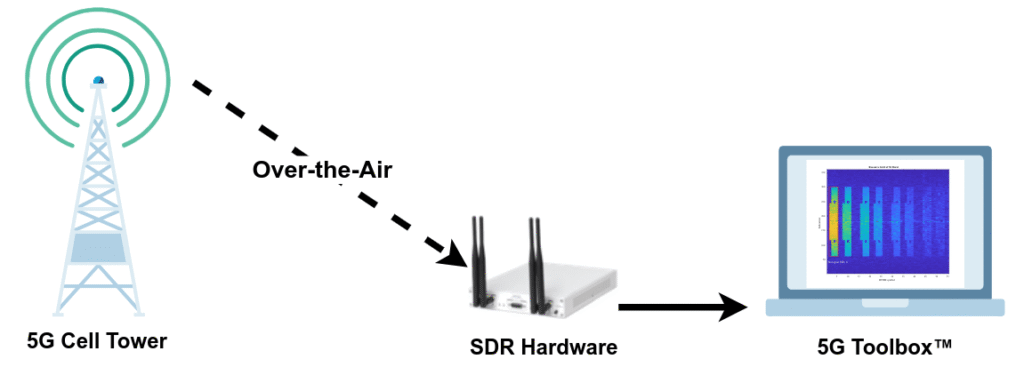The wireless communication underwent a great paradigm shift by 2025, with Software-Defined Radio (SDR) leading the change.
In addition to being a mere technical change, SDR has been attributed to a paradigm shift, which can offer adaptability and scalability to networks in line with the requirements of a fast-growing interconnected world.
As a result of SDR’s awareness of multiple communication standards, ability to integrate new technologies seamlessly, and to accelerate the roll-out of 5G, 6G, and other connections, the telecommunications, defense, IoT, and autonomous systems industries are therefore considered to be at the heart of SDR for next-wave connectivity.
Understanding Software-Defined Radio
Software-Defined Radio (SDR) is an advanced communication system that utilizes software algorithms, implemented in FPGAs or general-purpose processors, to either complement or replace traditional hardware components, such as mixers, amplifiers, and modulators.
Using this software approach, radios modulate, demodulate, and process signals through the use of programmable code, enabling them to adapt quickly to communication standards and protocols, and hardware adaptation is no longer an issue.
SDRs are a multi-purpose platform that resolve protocol constraints caused by hardware, supporting multiband, multiple modulation modes, and multiple communication protocols on the same device.
SDR characteristics, such as inherent flexibility and configurable and scalable technologies, position SDRs for a new generation of wireless networks, military communications, and new systems such as 5G, IoT, and cognitive radio systems, where adaptable performance is paramount.
The Rise of SDR in 2025
In recent years, the use of SDR technology has grown rapidly. There are several reasons for this increase:
1. Advancements in Digital Signal Processing (DSP)
Developments in contemporary DSP technology have significantly increased the efficiency and performance of Software-Defined Radio systems.
And these developments have enabled SDRs to undertake elaborate signal processing jobs at much higher speed and accuracy by catering to applications that can fit the whole range from military to telecom.
With improved DSP technology, the SDR systems will become more flexible, dependable, and address increasing operational needs.
2. Integration with Artificial Intelligence (AI)
Wireless networks are evolving due to the integration of AI in Software-Defined Radio platforms, which provide the network with adaptive features and intelligent decisions.
By integrating SDR with AI, it is possible to dynamically modify the performance of the network, mitigate interference, and allocate spectrum.
This combination of SDR and AI leads to enhanced flexibility, efficiency, and reliability of networks in enabling proactive adaptation to changing conditions and the seamless interaction with a variety of communication protocols.
3. Demand for Multi-Standard Support
The growth of Software Defined Radio (SDR) technology is being propelled by the demand for flexible and scalable communications solutions across all sectors.
It is becoming common for systems to work seamlessly across disparate protocols due to the growth of various aligned wireless standards.
The concern of SDR is its flexibility, which will not only ease the integration of new standards but will also provide effective, flexible, and future-proof solutions.
The Role of SDR in 2025 Wireless Networks
Facilitator of Cognitive Radio Systems
The development of cognitive radio systems is reshaped with the introduction of artificial intelligence and machine learning capabilities into SDR platforms.
Cognition allows these SDR platforms to handle spectrum access intelligently, optimize radio performance, and minimize interference.
Cognitive radios leverage cognitive features to provide a dynamic response to changing conditions in wireless communication networks.
They offer connectivity enhancements in environments where spectrum is constrained, thus improving the performance and reliability of wireless operations.
Backbone of Internet of Things (IoT) Connectivity
SDR technology provides the adaptability to support multiple devices across different communication protocols and frequency bands as IoT use increases.
Devices can effectively interact between platforms due to their versatility, which ensures seamless connectivity and compatibility across various IoT ecosystems.
SDR improves network scalability, reliability, and IoT deployment performance by enabling various protocols on a single device.
Enhancement of Public Safety Communications
The SDR is a game-changer in public safety communications as it offers communication networks that are secure, interoperable, and reliable.
Due to its programmable nature, it can be swiftly put into action and can be flexibly equipped to meet the changing needs of an emergency, thus allowing the first responders to be in communication at all times.
In fire situations, maintaining both clear communication and organized operations is essential. Using fire department software allows departments to manage checklists, track inventory, and stay prepared, ensuring teams can respond quickly and efficiently.
Through the provision of reliable communication, SDR facilitates coordination, situational awareness, and response efficiency, ultimately enhancing the effectiveness of emergency services in emergency scenarios.
Advancement of Military and Defense Applications
Software-Defined Radio (SDR), which can change its waveform and encryption by just a software update, is a significant breakthrough in military secure communications and the electronic warfare field.
Communications systems with such adaptability are not only interoperable and resilient, but they can also handle the most recent threats.
One of the main advantages of software-defined radio is that it provides military forces with a technological superiority in areas that are dynamic and contested, allowing them to expand the flexibility of operations and also to have better situational awareness.
Telecommunications
Software-Defined Radio (SDR) is a key utility that mobile network operators utilize to optimize their networks, manage spectrum efficiently, and deliver excellent services.
Via SDR, mobile network operators benefit from having an adaptable infrastructure that is scalable and compatible with the latest communication standards of varying widths.
As such, this enables them to maintain steady network access, optimize resource utilization, and rapidly implement new services in response to their customers’ growing demands.
SDR in 5G and Beyond

Software-defined radio (SDR) is changing the way 5G networks are deployed and evolved, in that it provides a level of flexibility and agility that has never been achieved.
SDR allows for dynamic spectrum access, the most significant feature of which is the ability to allocate and manage the spectrum resource in real time, improving both utilization and performance of the network.
SDR supports simultaneous use of multiple communication protocols, which guarantees seamless interoperability among various network environments.
The SDR software-based architecture allows new capabilities and updates to be performed without lengthy timelines and extensive costs associated with hardware upgrades.
SDR enables 5G networks to meet the diverse requirements of applications, ranging from ultra-reliable low-latency communications to high-speed transfers, by performing over a range of frequencies and protocols.
SDR is positioned as a key technology for networks that will be built on top of Beyond 5G (B5G) and 6G in the future.
The incorporation of AI and Machine learning will enable intelligent, self-governing wireless systems to have real-time decision-making capabilities, dynamic optimization, and predictive maintenance.
SDR provides the foundation needed to address the issues of next-generation networks, which will require advanced multi-standard capabilities, low latency, and large capacity.
Given the flexibility associated with SDR’s modulation schemes and frequencies, it will be critical to the efficient and scalable deployment of next-generation wireless technologies.
Challenges and Considerations
Software-Defined Radio (SDR) is a technology that comes with various advantages; nevertheless, there exist significant challenges in its implementation.
One of the problems could be power control, as reconfiguration is dynamic and may not be compatible with existing regulations, making regulatory compliance laborious.
Another big concern is security, as the programmability of SDR systems creates potential vulnerabilities that necessitate robust defenses.
Furthermore, SDR system deployment and design are intrinsically complicated, requiring specific knowledge to interface with old infrastructure and guarantee smooth operation.
Adoption success depends on careful planning and investment because of the high upfront expenditures for development, software, and hardware.
Software-Defined Radio Market
The global software-defined radio market is experiencing significant growth, driven by advancements in wireless communication and the increasing demand for flexible, programmable radio systems.
To improve spectrum management, update communication infrastructure, and aid in public safety and defense efforts, governments are spending more and more on SDR technology.
Initiatives like ‘Make in India’ and ‘Aatmanirbhar Bharat’ have boosted local SDR production in India, lowering the country’s reliance on foreign manufacture from 65–70% to a mostly domestic basis.
This emphasis on cutting-edge communication capabilities is demonstrated by the Ministry of Defence’s over ₹1,000 crore deal with Bharat Electronics Limited for SDR-Tac systems.
The Public Wireless Supply Chain Innovation Fund, which has US$420 million set aside to improve energy efficiency, spectrum-sensing technologies, and the programmability of SDR systems, is another way that the United States NTIA is fostering SDR innovation.
The Future Outlook
According to Pristine Market Insights, Software-Defined Radio (SDR) is expected to have a significant impact on the development of wireless communication as 2025 and beyond go by.
Its innate scalability and flexibility make it a vital component of sophisticated communication systems, such as the creation of 6G networks.
The combination of SDR with edge computing is one of the most important developments as it permits localized data processing, lowers latency, and facilitates almost immediate decision-making.
SDR platforms are well-positioned to accomplish autonomous network performance optimization when combined with AI-driven network management, improving resource allocation and operational effectiveness.
SDR’s entry into emerging markets demonstrates its affordability and adaptability, making it a viable option for expanding connectivity to rural and underserved areas.
SDR functionality will continue to be heightened in tandem with those of cognitive radio technology, enabling adaptability, even to various changing network conditions, and protecting spectrum usage.
Ultimately, the adaptability of SDR will ensure its relevance for global wireless development, ensuring that connectivity is delivered securely, efficiently, and everywhere, for any number of applications across everything.
By 2025, Software-Defined Radio (SDR) will have advanced the state of wireless communications by providing great functionality, flexibility, and adaptability.
SDR’s ability to provide seamless integration across different communication policies is paving the way for faster development and deployment of networks in many sectors.
SDR is advancing the rapid innovation associated with the advent of new technologies, improving connectivity reliability, and responding to the ever-growing demand for rapid and integrated communication.
SDR is a technical innovation, but it is truly a paradigm shift in the way wireless systems will be built, evolved, and expanded for an increasingly more connected world.









